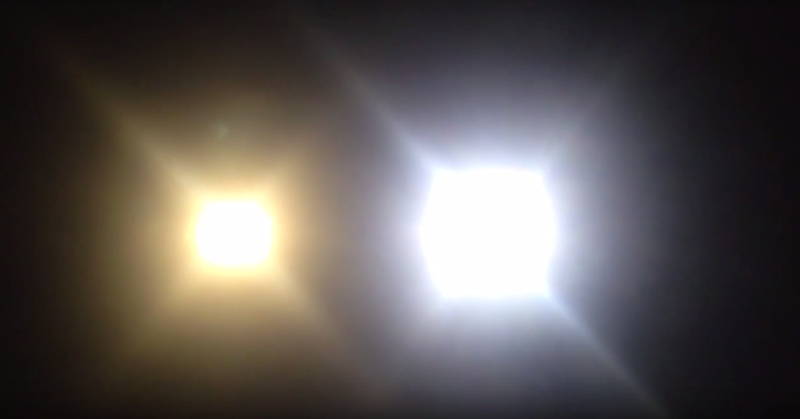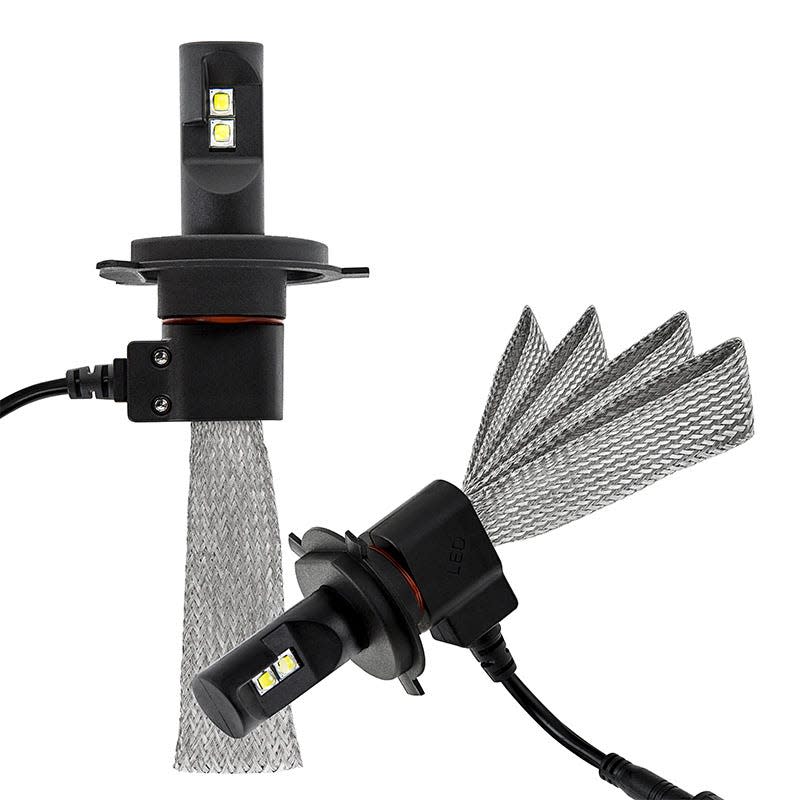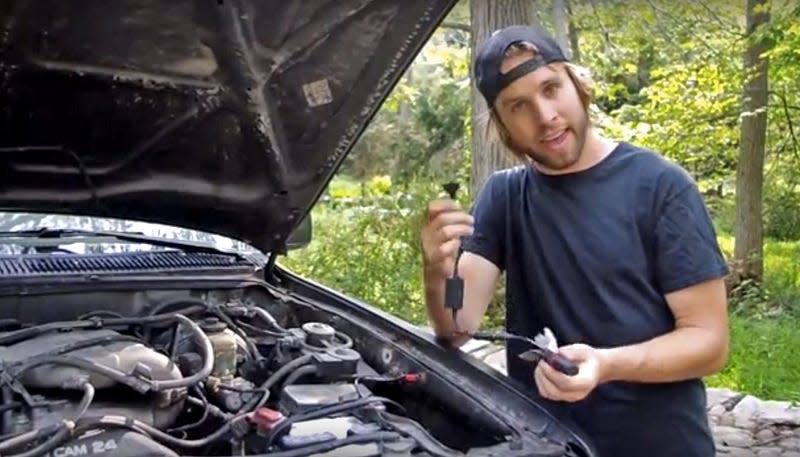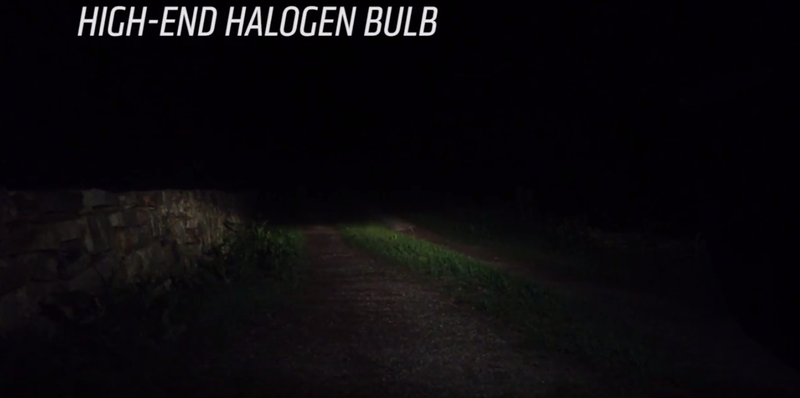Should You Swap Your Headlight Bulbs For LEDs?
LED headlights throw extremely intense light with very little draw on your car’s electrical system. Now that they’re trickling down to the aftermarket, you can buy a simple plug-in “LED retrofit kit” that straight swaps your halogen bulbs. We installed a set to see if that’s actually a good idea.
(Full disclosure: An outfit called SuperBrightLEDs.com [guess what they sell?] sent me some bulb-replacing LED units to install and try using. You’re seeing their H4 kit in action here.)
Read more
Check out the video above to see what it was like installing an LED kit for the first time and what the end result looked like. We’ve even taken the time to compare it to your cheapo O’ReillyZone dime-a-dozen parts store halogen bulb and a high-end Sylvania bulb. Aren’t we good to you?
If you can’t watch the video on your work computer, go take your phone to the toilet. Or just read the summary below, and then watch the video at home. I’m not going to tell you how to live your life.
What I’m saying is; you’ll get a better feel for the LED experience if you watch the video.
The Test: Halogen Bulb Vs. LED

Our trusty Typical Old Car is a 1996 Toyota 4Runner, which uses very common “H4” sized halogen headlight bulbs. It’s also got the wide-open eyes of an anime animal for light housings, which should give us a good indication of how the LEDs use a pre-LED car’s reflective bits.
Intensity of brightness is one thing but in order to really toss light way down the road your LED will have to bounce it through your stock headlight housing just as well as a halogen.
To see why that might be a concern, just take a look at the LED unit itself.

While a halogen bulb is inherently omnidirectional, LEDs only project from those tiny little points (diodes.) The units in our kit have four little diodes a piece, which increase from extremely bright on the low-beam setting to retina-cleansing on the high-beam setting.
LED Bulb Technology

You probably know how an incandescent light bulb works. Simply think of a great idea, and one appears above your head. An example of such an idea might be an artificial light source made of a wire stuffed into a clear housing. Run electricity though the wire and boom; you’ve got yourself some illumination-on-command.
A halogen light is basically just that plus a “parabolic aluminized reflector to improve the focus of the light,” as explained by California’s Consumer Energy Center. Or “a curved metal thingy to shine more light off” as explained by me.
You can see a typical halogen headlight bulb in the picture above, and the bionic squid-looking thing above that is an LED replacement unit. Working from the front to the back; you probably already worked out that the “head” is where the light comes from. Those silver shoelacey-looking things are heat sinks; LEDs don’t make heat where they get bright but they do get rather hot behind the diodes. After just a few seconds of operation, touching those heat sinks will be uncomfortable.
From there, the power cable (which disconnects to ease installation) runs through some kind of resistor to compensate for a range of voltage in different vehicles and plugs right into the same three-pronged clip that attached to your halogen bulb.
Why Choose LEDs?
From a practical standpoint; they’re ultra-bright and theoretically will last an extremely long time. They also draw less power than a typical halogen bulb; our H4 kit is advertised at consuming 1.4 amps as opposed to 5 amps sucked up by a halogen bulb.
On one hand; who cares, your car was obviously designed to run with whatever draw your factory headlights had. On the other this takes some tax off your electrical system and might help your battery last longer. Especially if you’re running extra accessories like a fridge or a disco ball or a bitchin’ car stereo.
Finding the Right “Bulb” and Installing it

Pretty much every site selling LED bulbs has some sort of tool to tell you which part you need specifically. For example; you can check out the vehicle bulb finder we used to get the 4Runner’s headlights on SuperBrightLEDs.com. If you’re too lazy to do that, I’m sure you can call your LED purveyor of choice and say “I need bulbs for my 1991 Geo Metro” and they’ll take care of you.
Now if you really put your mind to it, you could probably work up a completely proprietary LED headlight system using diodes and circuits from an engineering supply outfit, and constructing your own wiring system. That’d probably be cheaper, but the advantage of a prepackaged kit is ease of installation.
And it is easy; just pop out your halogen bulb and stick the LED unit in its place. Heck, if you’ve never opened your hood before this is a great job to start on.
Accessing your bulbs might be a bit of a pain depending on how your engine bay’s laid out, but I can promise you’re going to get annoyed trying to cram those gawky heat sinks somewhere they won’t light anything on fire.
Just kidding, I don’t think there’s much actual risk of that, but these things do take up a ton of space and you’re going to spend some time fiddlin’ to get them tucked away nicely.
You can see how the new unit goes into the 4Runner in our video above, or check out SuperBright’s installation-focused clip here.
Pro tip: avoid touching the glass part of a halogen bulb with your bare fingers. Your skin-oil can imprint onto it and weaken its ability to project. No sense in damaging them if they still work, you never know when one of your vehicles might need a bulb. Or you might want to switch back at some point.
Don’t forget to make sure your headlights are aimed correctly. Changing your bulb shouldn’t throw this off, but there’s probably a screw on the housing that will push it up or down. Take your vehicle to a certified inspection station to calibrate your headlights at their specially marked wall. Or, just eyeball it.
Alright, Let’s See These Things in Action
With our truck parked in the exact same spot, I loaded each type of bulb into the left headlight only and shined ‘em down my driveway. Why only one bulb? For the sake of comparison, I thought it’d be more prudent to– okay fine, I accidentally broke one of my standard halogens and the car store was closed. So this was the “most fair” way for the show to go on.
Take a look for yourself, and see how the lights look static:



Driving Comparison
You’ve really got to watch the video to get a feel for this. Did I mention we made a video demonstration?
The more I look at the photos above, the more obvious it seems that the LED is superior. But while I was driving, it really felt like the halogen had a significantly longer throw which might be more valuable to you than close-range brightness.
What I Liked About the LED Headlights
I could make out every pebble on the road for ten meters and more ahead of the truck. As long as you’re not falling asleep at the wheel, your days of running over things “because nighttime” are over.
That “instant-on” effect is sexy as hell.
The housing itself became ultra-visible from the outside, this would be great for keeping track of where my truck’s at in the desert. Especially from far away.
Love the idea of “surplus power” in my truck’s electrical system, I’m gonna need it when that fridge goes in.
Did I mention these lights look cool?
What I Didn’t Like About the LED Headlights
Borderline dangerously bright for oncoming traffic. Blinding other cars is no better than not being able to see yourself.
Just how hot the heat-sinks got was a little disconcerting. Even with all the safety guarantees from the purveyor, I’d want to be extremely wary of how they were positioned.
Throw-distance felt shorter than halogens; a big disadvantage for high-speed driving. But what’s more, the LEDs had a very tight flood pattern. I like the way traditional lights bleed into the woods a bit; the LEDs didn’t do that as much.
LED headlight retrofits from SuperBright and anybody else I know of are technically not street legal. Truth is, a lot of aftermarket light bulbs aren’t actually DOT certified. You’re probably never going to get in trouble and I bet you’d pass a state vehicle inspection just fine; the only thing that’d scare me would be the lawsuit potential if you’re involved in an accident. Imagine you hit somebody and their attorney finds out your headlights weren’t legal for road use? Seems like substantial headache potential there.
Verdict

I’m absolutely in love with LEDs as fog lights, auxiliary lights, and camp lights. They can be a little harsh as dome lights.
But LEDs really shine (GET IT?) when they’re put to work in an application where “being seen” or short-range visibility is a priority, like on backup lights or brake lights.
The intensity is great, and the more bulbs you convert the less work your car’s electrical system has to do. But I still think high-performance halogens are awesome when it comes to your primary driving headlight, and for now they might still be the way to go.
More from Jalopnik
Sign up for Jalopnik's Newsletter. For the latest news, Facebook, Twitter and Instagram.

 Yahoo Autos
Yahoo Autos 